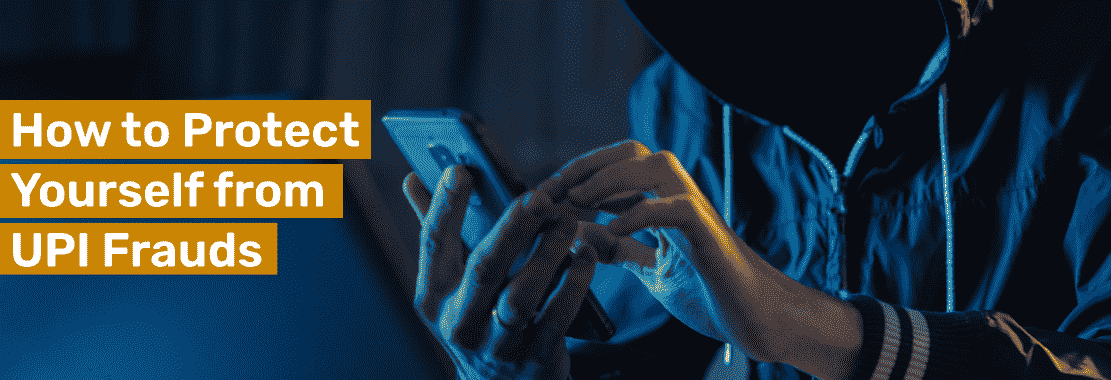Digitalisation has come a long way in India and has grown tremendously in all aspects of our lives. This includes online payments too. This is where the provision of UPI comes to the fore. UPI or Unified Payments Interface has truly made online payments convenient. However, where there are benefits, certain drawbacks also exist.
There are quite a few drawbacks to using UPI, out of which UPI fraud is a major one. In his blog, we will take a look at everything you need to know about these UPI frauds including types of UPI frauds, how to prevent them and what to do if you fall victim to them.
What is UPI Fraud?
Since UPI is all about digital transactions, any kind of fraudulent activity concerning UPI transactions can be classified as UPI fraud. The provision of UPI enables users to transfer funds from one bank account to another with the help of their mobile phone. There is no doubt that UPI has indeed made carrying out transactions easier. However, at the same time, it has also made users more susceptible to various UPI frauds.
Common UPI Payment Scams
To know what to avoid or be aware of when using UPI, users also need to stay informed about the different kinds of UPI payment scams. Listed below are some of the most common ones:
Phishing Scams:
Phishing scams have become one of the most common ways for fraudsters to take advantage of UPI customers. As a part of a phishing scam, scammers will send fake UPI links to users or ask them to share extremely sensitive information like their UPI PINs, passwords or OTPs. This sort of communication is usually done through text messages, emails or phone calls. If a UPI user ends up sharing any of the sensitive information through these links, then it is used by the scammers to transfer funds from a user’s account and use it for their means.
Fake UPI Payment Requests:
This scam is exactly like it sounds. Under this scam, fraudsters, often posing as service providers, send fake UPI payment requests to users. Oftentimes, the request appears so genuine that unsuspecting users end up authorizing the payment. This authorizes a fund transfer to the scammer’s account. Fake UPI payment requests are most common in online marketplaces or even in social media transactions.
Remote Access Scams
Though remote access scams are not as common as other UPI frauds, they involve the use of remote access apps like AnyDesk or TeamViewer. Under such scams, the perpetrators convince users to download these remote access apps under the guise of trying to help them solve a technical issue on their device. Once the user downloads these apps, the fraudsters can gain control of the user’s device and access sensitive information, including UPI credentials. This will enable them to carry out fraudulent transactions.
QR Code Scams
Users who are unaware of how QR codes are used in UPI are the most common victims of these scams. Under such scams, scammers share a QR code with the user, asking them to scan it if they want to receive funds. However, when users do so, they end up unconsciously authorising a payment to the scammer.
SIM Swap Frauds
SIM swap frauds can easily go undetected up until the time there is significant financial loss. In such a fraud, scammers can get their hands on the duplicate of the user’s number through which they can intercept OTPs and even authorise UPI transactions from the user's bank account.
Prevention Tips for Avoiding UPI Frauds
Though UPI frauds have become common, there are quite a few ways through which users can avoid falling prey to them. Here are some tips that users can follow to steer clear of potential UPI frauds.
It is of the utmost importance that users verify the source that is sending them the UPI payment requests, messages or calls, before responding. This helps identify whether or not the request is genuine.
Users need to keep all their important information like UPI IDs, passwords or OTP under lock and key and be very selective about who they are sharing this information with.
Always double and triple-check to see that the QR code you are about to scan is of a trusted source. You could also check again with the sender to ensure it is them who has sent it to you.
Any applications that you need should be downloaded from trusted sources like Google Play or Apple App Store. Downloading remote access apps should be done with caution and should ideally be avoided unless necessary.
When you frequently go through your bank statements and your UPI transactions, you will be able to discover whether there has been any suspicious or unauthorised activity.
Do not share your mobile number with anyone you do not personally know. This is especially true concerning unfamiliar websites or unknown individuals.
What to Do if You Become a Victim of UPI Fraud?
There are times when, despite taking every precaution, users might fall into the trap of UPI fraud. So what can one do then? Listed below is a step-by-step guide on what to do if this happens.
If you know you have fallen into a UPI fraud trap, the very first thing that needs to be done is to contact your bank to let them know about the fraudulent transaction. You can further ask your bank to block your UPI account or temporarily freeze your bank account temporarily
Another thing you need to do if you become a victim of a UPI fraud is to complain to the local cybercrime cell. You could also use the National Cyber Crime Reporting Portal to report the fraud.
If you suspect you have become a victim of UPI fraud, then you must change your UPI PIN to avoid any further unauthorised transactions.
Safeguard Your Money from UPI Fraud
There is no doubt that UPI has made transferring funds from one account to another easier. However, with the benefits, there have been specific drawbacks and frauds that accompany UPI transactions. This is why it is important to stay informed about the different types of UPI scams. This will, to a great extent, help reduce the risk of becoming a victim of UPI fraud.
Disclaimer: Investments in the securities market are subject to market risk, read all related documents carefully before investing.
This content is for educational purposes only. Securities quoted are exemplary and not recommendatory.
For All Disclaimers Click Here: https://bit.ly/3Tcsfuc














